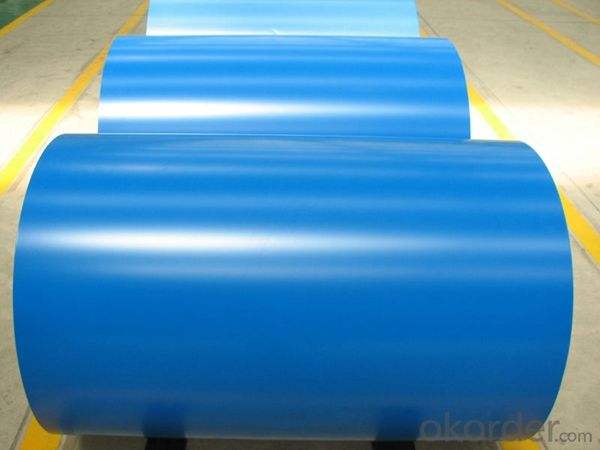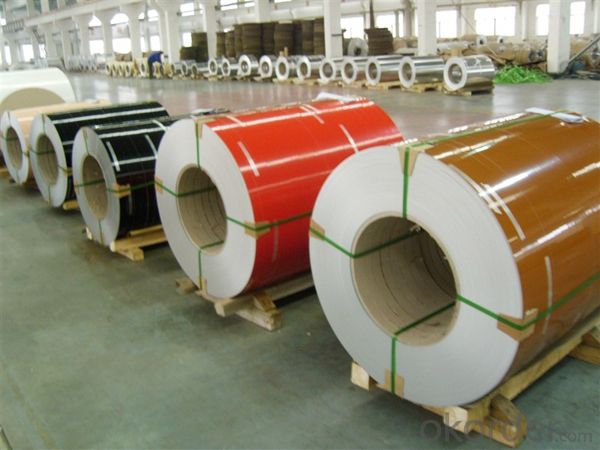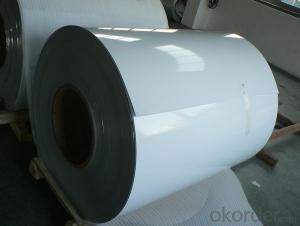Color Coated Aluminum Coil for Curtain Walls
- Loading Port:
- Shanghai
- Payment Terms:
- TT OR LC
- Min Order Qty:
- 5 m.t.
- Supply Capability:
- 10000 m.t./month
OKorder Service Pledge
OKorder Financial Service
You Might Also Like
Item specifice
1. Specification of Color Coated Aluminum Coil for Curtain Walls
characteristics | Application |
1) Super peeling strength | 1) Building exterior curtain walls |
2) Excellent surface flatness and smoothness | 2) Decoration and renovation additions for old buildings |
3) Superior weather, corrosion, pollutant resistance | 3) Decoration of interior walls, ceilings, bathrooms, kitchens and balconies |
4) Even coating, various colors | 4) Shop door decorations |
5) Fireproof, excellent heat and sound insulation | 5) Advertisement board display platforms and signboards |
6) Superior impact resistance | 6) Wallboards and ceilings for tunnels |
7) Lightweight and easy to process | 7) Industrial materials, materials for vehicles and boats |
2. Application of Color Coated Aluminum Coil for Curtain Walls
(1).Interior: wall cladding, ceilings, bathrooms, kitchens and balconies, shutters, doors...
(2).Exterior: wall cladding, facades, roofing, canopies, tunnels, column covers , renovations...
(3).Advertisement: display platforms, signboards, fascia, shop fronts...
3. Feature of Color Coated Aluminum Coil for Curtain Walls
*Such coil is specially designed to replace aluminum ingot, due to the high export tax of aluminum ingot, the coil has better price than ingot.
*This type of coil can fit customer's remelting furnace just like ingot, no need to make any change to the production line that was previously used for ingot. The standard coil size and weight is very suitable for the feed gate of furnace.
*This type of coil causes less material wastage than ingot when remelted.
*Our coil is made directly from ore, no need to go though the ingot making process, quality is much better than other suppliers who use ingot scrap to make coil.
Be free from Oil Stain, Dent, Inclusion, Scratches, Stain, Oxide Dicoloration, Breaks, Corrosion, Roll Marks, Dirt Streaks and other defect which will interfere with use
4. Certificate:
SGS and ROHS(if client request, paid by client), MTC(plant provided), Certificate of Origin(FORM A, FORM E, CO), Bureau Veritas and SGS (if client request, paid by client), CIQS certificate
5. Image of Color Coated Aluminum Coil for Curtain Walls



6. Package and shipping of Color Coated Aluminum Coil for Curtain Walls
eye to wall
eye to the wall
with wood pallet (wooded case also available)
7. FAQ
1) What is the delivery time?
Dpends on actual order, around 20 to 35 days
2)What is the QC system:
We have QC staff of 20 persons and advanced equipment, each production is with MTC traced from Aluminum ingot lot.
3) What market do you mainly sell to?
Australia, America, Asia, Middle East, Western Europe, Africa etc
- Q:How do aluminum coils perform in cryogenic environments?
- Due to their low thermal expansion coefficient and high thermal conductivity, aluminum coils have excellent performance in cryogenic environments. When subjected to extremely low temperatures, aluminum coils display minimal contraction and expansion, making them suitable for cryogenic applications. The coils' low thermal expansion coefficient ensures that they maintain their structural integrity and do not deform or crack when exposed to extreme temperature fluctuations. Moreover, aluminum's high thermal conductivity facilitates efficient heat transfer, enabling the coils to effectively dissipate excess heat and maintain a stable temperature in the cryogenic environment. All in all, aluminum coils are a dependable choice for use in cryogenic environments and can effectively withstand the challenges presented by extremely low temperatures.
- Q:How are aluminum coils cut to length?
- Aluminum coils are typically cut to length using specialized machinery such as slitters or cut-to-length lines. These machines use sharp circular blades or shearing mechanisms to accurately and precisely cut the coils into desired lengths. The process involves unwinding the coil, passing it through the cutting mechanism, and then rewinding the cut pieces.
- Q:What are the different coil transportation options for aluminum coils?
- The different coil transportation options for aluminum coils include truck transportation, rail transportation, and container transportation.
- Q:How are aluminum coils processed for specific surface finishes?
- Aluminum coils are processed for specific surface finishes through a series of steps that involve cleaning, pretreatment, coating, and curing. The first step in processing aluminum coils is cleaning. This involves removing any dirt, oil, or other contaminants from the surface of the coils. Cleaning is typically done using a combination of chemical cleaners and mechanical methods, such as scrubbing or brushing. After cleaning, the coils undergo a pretreatment process. Pretreatment is essential to ensure proper adhesion of the surface finish. It involves the application of a chemical solution or coating that prepares the surface of the aluminum for the subsequent coating. This step typically includes processes like etching, desmutting, and deoxidizing, which help improve the surface quality and promote adhesion. Once the coils have been cleaned and pretreated, they are ready for coating. The specific coating method depends on the desired surface finish. Some common coating techniques include coil coating, anodizing, painting, or powder coating. Coil coating involves the application of a liquid coating onto the surface of the aluminum coils. Anodizing is an electrochemical process that creates a durable and corrosion-resistant layer on the surface. Painting and powder coating involve the application of a dry paint or powder onto the coils, which is then cured to form a protective and decorative finish. After the coating is applied, the coils go through a curing process. Curing involves subjecting the coated coils to high temperatures, which causes the coating to chemically react and harden. This step is crucial for achieving the desired properties and durability of the surface finish. Overall, the processing of aluminum coils for specific surface finishes involves a combination of cleaning, pretreatment, coating, and curing steps. These processes ensure that the coils are properly prepared and coated to achieve the desired surface finish, whether it be for protection, aesthetics, or specific functional requirements.
- Q:How are aluminum coils processed for further fabrication?
- Aluminum coils are processed for further fabrication through a series of steps, including cleaning, annealing, leveling, slitting, and recoiling. The cleaning process removes any impurities or contaminants from the surface of the coils. Annealing involves heating and cooling the coils to enhance their ductility and make them easier to work with. Leveling ensures uniform thickness and flatness across the coils. Slitting involves cutting the coils into narrower strips of desired width, while recoiling is done to create smaller coils for specific applications.
- Q:How are aluminum coils used in the production of architectural panels?
- Aluminum coils play a crucial role in the production of architectural panels by serving as the primary material for their construction. These coils are typically made from high-quality aluminum alloy, which possesses several desirable characteristics such as lightweight, corrosion resistance, and malleability. The first step in using aluminum coils for architectural panels involves uncoiling the raw material. The coils are unwound and flattened to create flat sheets of aluminum. These sheets are then cut to the desired size and shape, depending on the specific architectural panel design requirements. Once the aluminum sheets are prepared, various manufacturing techniques can be used to further process them. These techniques include bending, folding, welding, and punching to achieve the desired panel shape and functionality. The malleability of aluminum allows for precise shaping and customization, making it an ideal material for architectural panel production. Additionally, aluminum coils can be coated or treated to enhance their appearance, durability, and performance. Coatings such as paint, powder coating, and anodizing can be applied to the aluminum surface to provide protection against weathering, UV radiation, and corrosion. These coatings can also offer aesthetic options, allowing architects and designers to choose from a wide range of colors and finishes for their architectural panels. Architectural panels manufactured using aluminum coils offer numerous benefits. Firstly, due to the lightweight nature of aluminum, these panels are easier to handle and install, reducing labor costs and time. Additionally, aluminum's corrosion resistance ensures that architectural panels remain durable and visually appealing even in harsh weather conditions. The malleability of aluminum also allows for intricate designs and complex shapes, enabling architects to create visually striking and unique building facades. In conclusion, aluminum coils are an essential component in the production of architectural panels. Their lightweight, corrosion resistance, and malleability properties make them an ideal material for creating durable and aesthetically pleasing panels. Whether it is for high-rise buildings, residential homes, or commercial structures, aluminum coils are instrumental in the production of architectural panels that enhance the visual appeal and functionality of modern architecture.
- Q:What are the weight considerations when using aluminum coils?
- When incorporating aluminum coils, there are various factors to consider regarding weight. To begin with, aluminum coils generally possess a lighter weight in comparison to other metals, such as steel. This characteristic makes them a favored choice in industries prioritizing weight reduction, like automotive manufacturing or aerospace applications. The lightweight nature of aluminum coils leads to enhanced fuel efficiency in vehicles and increased payload capacity in airplanes. Furthermore, it is important to take into account the weight of the aluminum coil itself. Depending on the specific usage, the coil's weight may need to fall within certain limits to ensure proper functionality and structural integrity. For instance, in HVAC systems, the weight of the aluminum coil must be appropriate for secure mounting and capable of withstanding vibrations or pressure changes. Moreover, the weight of the aluminum coil can impact transportation and installation. Lighter coils are simpler to handle, transport, and install, thereby reducing the time and effort required for these processes. This advantage can be particularly valuable in construction projects that involve a large quantity of aluminum coils. Additionally, it is crucial to consider the weight-bearing capacity of the structures or equipment that will support or utilize the aluminum coils. The combined weight of the coils, along with any additional components or materials, should not exceed the load capacity of the system to prevent structural failure or safety hazards. Lastly, the weight of aluminum coils can influence cost considerations. Since the price of aluminum is typically based on weight, lighter coils may prove to be more cost-effective when compared to heavier alternatives. However, it is important to strike a balance between weight reduction and meeting the required performance and strength specifications. In conclusion, weight considerations when using aluminum coils encompass various factors, including the overall benefits of weight reduction, the weight of the coil itself, ease of transportation and installation, load-bearing capacity, and cost implications. Taking these considerations into account ensures the successful and efficient utilization of aluminum coils in diverse industries and applications.
- Q:What are the common surface protection methods for aluminum coils?
- The common surface protection methods for aluminum coils include anodizing, painting, and coating with protective films or laminates.
- Q:I don't know, I see a metal is a metal. I understand that a bike shop bike has better service and the bike has better components. Yet I just feel the frame of a $500 bike store bike and a $100 bike from Walmart using aluminum is the same. It's like people charging $100 for audio/video cables when a $1 no-name cable works the same for tv. Is this the same marketing ploy in the bike industry?I see a Mongoose bike for $500 to $1000 on their website, yet I see one with the same frame metal at Walmart/Kmart for only $100. Mongoose is a reputable name. What gives?What do you think? Is the metal quality in a $500 aluminum bike shop bike the same as a $100 aluminum department store bike?
- Aluminum Mountain Bike
- Q:Can aluminum coils be used in chemical processing equipment?
- Indeed, chemical processing equipment can utilize aluminum coils. Aluminum possesses remarkable corrosion resistance, rendering it appropriate for deployment in numerous chemical settings. Its resistance extends to various acids, alkalis, and other corrosive elements. Moreover, aluminum coils are lightweight and possess commendable heat transfer qualities, rendering them optimal for scenarios necessitating heat exchange. Nonetheless, it is crucial to acknowledge that aluminum exhibits restrictions in specific aggressive chemical environments, such as potent acids like hydrochloric acid or sulfuric acid. In such instances, alternative materials such as stainless steel or titanium may prove more fitting.
1. Manufacturer Overview |
|
|---|---|
| Location | |
| Year Established | |
| Annual Output Value | |
| Main Markets | |
| Company Certifications | |
2. Manufacturer Certificates |
|
|---|---|
| a) Certification Name | |
| Range | |
| Reference | |
| Validity Period | |
3. Manufacturer Capability |
|
|---|---|
| a)Trade Capacity | |
| Nearest Port | |
| Export Percentage | |
| No.of Employees in Trade Department | |
| Language Spoken: | |
| b)Factory Information | |
| Factory Size: | |
| No. of Production Lines | |
| Contract Manufacturing | |
| Product Price Range | |
Send your message to us
Color Coated Aluminum Coil for Curtain Walls
- Loading Port:
- Shanghai
- Payment Terms:
- TT OR LC
- Min Order Qty:
- 5 m.t.
- Supply Capability:
- 10000 m.t./month
OKorder Service Pledge
OKorder Financial Service
Similar products
New products
Hot products
Hot Searches
Related keywords





























